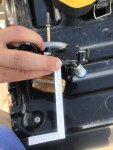MidwestFloater
Cadet
- Joined
- Jun 9, 2019
- Messages
- 20
Hi all, I'm having issues with my MCM 3.0 181. I recently rebuilt the carb on this unit using a kit from Mike's carb parts. While the system is generally performing much better than prior to rebuild, I'm not having significant flooding issues when I shut the engine off. After running and getting the engine warm, it continues to drip gas into the carb after shutting the engine off. It's a pretty significant flow and resulted in large amounts of gas collecting on top of the throttle body. From the sounds of it, this can be caused by a few things. Here's what I have on my troubleshooting list.
- Needle / seat issue
- Float level / drop settings
- Fuel system pressure
As I rebuild the carb recently, I'm guessing it's something associated with that. I took the carb off/apart today and didn't see any debris or obstruction in the needle/seat area.
I then went on to check the float level/drop settings and ran into an issue. From my manual, I'm getting a float level of 9/16" and float drop setting of 1-3/32". However, I believe the instructions with my float indicated measure these settings to the toe of the float. On the Mike's carb parts site, it indicates measuring to the bottom of the float for float drop.
Float drop settings: https://www.marineengine.com/parts/technical_information/sierra_18-7097.pdf
Mike's Carb settings: https://www.carburetor-parts.com/Float-Adjustment_ep_615.html
However, 1-3/32" to the bottom of the float would seem to have the float nearly at the same position as the float level settings (see pic). You can't really tell from the pic, but the ruler is on the gasket and the float is hanging. I had initially measured the distance to the toe (upper right portion in pic).
So a few questions
- Where am I supposed to measure to on the brass float? The toe or the bottom?
- If it's the bottom, does it seem like I have something wrong in my setup (other than the setting obviously)?
- What other things might be causing the flow after shutoff?
Let me know if other info would be helpful. Thanks for the help!
- Needle / seat issue
- Float level / drop settings
- Fuel system pressure
As I rebuild the carb recently, I'm guessing it's something associated with that. I took the carb off/apart today and didn't see any debris or obstruction in the needle/seat area.
I then went on to check the float level/drop settings and ran into an issue. From my manual, I'm getting a float level of 9/16" and float drop setting of 1-3/32". However, I believe the instructions with my float indicated measure these settings to the toe of the float. On the Mike's carb parts site, it indicates measuring to the bottom of the float for float drop.
Float drop settings: https://www.marineengine.com/parts/technical_information/sierra_18-7097.pdf
Mike's Carb settings: https://www.carburetor-parts.com/Float-Adjustment_ep_615.html
However, 1-3/32" to the bottom of the float would seem to have the float nearly at the same position as the float level settings (see pic). You can't really tell from the pic, but the ruler is on the gasket and the float is hanging. I had initially measured the distance to the toe (upper right portion in pic).
So a few questions
- Where am I supposed to measure to on the brass float? The toe or the bottom?
- If it's the bottom, does it seem like I have something wrong in my setup (other than the setting obviously)?
- What other things might be causing the flow after shutoff?
Let me know if other info would be helpful. Thanks for the help!




















